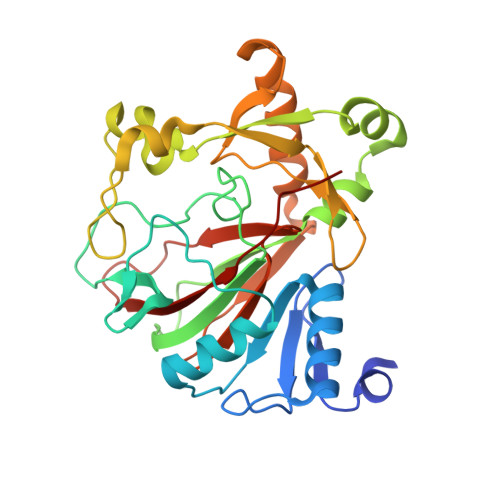Molecular basis for enantioselective herbicide degradation imparted by aryloxyalkanoate dioxygenases in transgenic plants.
Chekan, J.R., Ongpipattanakul, C., Wright, T.R., Zhang, B., Bollinger Jr., J.M., Rajakovich, L.J., Krebs, C., Cicchillo, R.M., Nair, S.K.(2019) Proc Natl Acad Sci U S A 116: 13299-13304
- PubMed: 31209034
- DOI: https://doi.org/10.1073/pnas.1900711116
- Primary Citation of Related Structures:
5BK9, 5BKB, 5BKC, 5BKD, 5BKE - PubMed Abstract:
The synthetic auxin 2,4-dichlorophenoxyacetic acid (2,4-D) is an active ingredient of thousands of commercial herbicides. Multiple species of bacteria degrade 2,4-D via a pathway initiated by the Fe(II) and α-ketoglutarate (Fe/αKG)-dependent aryloxyalkanoate dioxygenases (AADs). Recently, genes encoding 2 AADs have been deployed commercially in herbicide-tolerant crops. Some AADs can also inactivate chiral phenoxypropionate and aryloxyphenoxypropionate (AOPP) herbicides, albeit with varying substrate enantioselectivities. Certain AAD enzymes, such as AAD-1, have expanded utility in weed control systems by enabling the use of diverse modes of action with a single trait. Here, we report 1) the use of a genomic context-based approach to identify 59 additional members of the AAD class, 2) the biochemical characterization of AAD-2 from Bradyrhizobium diazoefficiens USDA 110 as a catalyst to degrade ( S )-stereoisomers of chiral synthetic auxins and AOPP herbicides, 3) spectroscopic data that demonstrate the canonical ferryl complex in the AAD-1 reaction, and 4) crystal structures of representatives of the AAD class. Structures of AAD-1, an ( R )-enantiomer substrate-specific enzyme, in complexes with a phenoxypropionate synthetic auxin or with AOPP herbicides and of AAD-2, which has the opposite ( S )-enantiomeric substrate specificity, reveal the structural basis for stereoselectivity and provide insights into a common catalytic mechanism.
- Department of Biochemistry, University of Illinois at Urbana-Champaign, Urbana, IL 61801.
Organizational Affiliation:



















